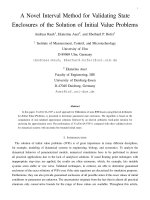RELEASE NOTES FOR VERSION 1.0 OF THE DATABASE pdf
Bạn đang xem bản rút gọn của tài liệu. Xem và tải ngay bản đầy đủ của tài liệu tại đây (169.91 KB, 6 trang )
Release Notes May 2004
RELEASE NOTES FOR VERSION 1.0 OF THE DATABASE
John C. Martin, University of Minnesota
(If you use information or advice from this memo, please acknowledge it and
the net site in any resulting publications; thanks.)
1. Introduction to Version 1.0
This is version 1.0 of the data gathered by the HST Eta Carinae Treasury Project using the HST
Space Telescope Imaging Spectrograph (STIS) CCD. This initial release includes several
improvements over normal STScI pipeline and CALSTIS reductions which are detailed below
(Section 2). The data have epochs spanning from January 1998 through March 2004, including
intensive coverage of the 2003.54 spectroscopic event. Note that this release includes nearly all
the spectroscopic data which will be gathered using the HST/STIS CCD for this project.
However, at the same time it represents only the first stages of the data reduction. Additional
processing and software will become available later this year. For more information on the full
extent of the HST Eta Carinae Treasury Project please visit our web site ().
2. Items Of Interest Pertaining to Version 1.0
The following items pertain to the release of Version 1.0 of the database:
a) New File Naming Scheme
We have adopted a naming scheme which differs from that used with the earlier releases of data
to team members. All future versions and releases will use these file names. The conventions of
this naming scheme are fairly simple, as detailed in Technical Memo number 3 on our web site:
/>
2
b) Improved Pixel Interpolation
The improved techniques used to model and interpolate the pixels in the STIS CCD are outlined
in Technical Memo number 1 on our web site:
This technique has improved the effective resolution of the STIS CCD on the dispersion and
cross-dispersion axis since the previously used scheme effectively acted as a position dependent
blurring function. Data reduced by the new method are of a quality which surpasses other
available data processing techniques for STIS CCD data. The “scalloping” which is obvious in
narrow extractions from data reduced by the former methods is almost completely eliminated by
this new method. See the illustration in Appendix A and Technical Memo number 1 for full
details.
Also note that the reduced data have been rebinned so that one pixel in the raw data corresponds
to two pixels in the reduced data (the effective pixel scale in the reduced data is about 0.025035
arcsecond/pixel).
c) Bad/Hot Pixel Removal
Bad pixels (hot pixels, cosmic ray hits, etc.) were identified in this data by two independent
techniques. First, we applied the standard CR-SPLIT method which is familiar to HST users.
The standard CR SPLIT method requires at least two exposures (a condition that was not always
met) and can miss a few bad pixels that appear in all the individual frames. Therefore, we
developed a second technique which is capable of identifying bad pixels without requiring
multiple exposures.
Our method relies on the fact that a legitimate point source is sampled by several pixels on the
STIS CCD. Each pixel is compared with its neighbors in 5x5 square centered on that pixel.
After rejecting the two highest and lowest neighboring values, we calculate the mean (V
avg
) and
the r.m.s. dispersion (D) of the 20 remaining comparison pixels. The R value of the pixel being
tested (V
0
) is assessed by the expression:
DVVR
avg
/
0
−=
. In the cases where R exceeds a
well-chosen threshold (R
c
) the pixel is flagged as bad. By iterating this process, sizeable clusters
of bad pixels can be identified and eliminated. This method was carefully tuned and tested so
that it eliminates nearly all the obviously bad pixels in a single exposure without adversely
altering the noise structure of the data or the data itself.
A more detailed technical memo on this technique will be made available at a later date.
d) Wavelength Calibration
The wavelength calibration has been rigorously verified by measuring the wavelengths of narrow
stellar photospheric spectral features in standard stars reduced in the same manner as the Eta
Carinae data. The current wavelength calibration meets or exceeds the standard set by the StScI
pipeline and CALSTIS. Remaining wavelength errors may result from imperfect pointing of the
STIS slit.
3
e) Flux Calibration
The flux calibration of the data was checked by comparing standard stars BD +75 325 and AGK
+81 266, reduced by our technique, with data published by Bohlin et al. (2001). The current flux
calibration in version 1.0 meets or exceeds the standard set by the StScI pipeline and CALSTIS
for extended source spectral flux calibration across the entire range of wavelengths and epochs
covered by this data.
f) Centering of the Nominal Target on the Cross-Dispersion Axis
We have determined the location (fractional row number) where the nominal center of the slit
actually falls during each observation by comparing a plot of the cross dispersion axis in each
observation to a slice extracted from HST ACS/HRC images taken with the appropriate filters.
The WCS information in the FITS headers has been edited so that the CCD row where the
nominal target appears is identified by the keyword CRPIX2. Also, as per the findings of
Bowers & Baum (1998), the cross-dispersion pixel scale has been set to 0.025035
arcseconds/reduced pixel (CD2_2 FITS header keyword). As a result, the WCS information
should return the proper coordinate along the slit, with the nominal target located at zero. In
most cases, the centering of the nominal target is accurate to better than ±0.0127 arcseconds (half
a reduced pixel).
g) Flagging Bad Pixels Which Result from Exposure Saturation
Nonlinear interactions between the distortion correction and the pixel interpolation technique
make it a non-trivial task to identify pixels in the final reduced data which may have been
adversely affected by pixels that are saturated by overexposure in the raw data. Unfortunately,
one cannot rely on the Data Quality (DQ) array in the FITS files to properly identify all of the
bad pixels. A list of the observations which have over-exposed pixels (identified from the raw
data files) is available on our web site at:
/>
In many cases the raw exposure with the saturated pixels has a shorter companion exposure with
the same grating tilt and target at the same epoch. In those cases, we were able to compare the
reduced data from the long exposure (with the saturated pixels) to the shorter exposure (without
saturated pixels) in order to determine which pixels have been adversely affected in the longer
exposure. Very conservative tolerances were used to identify the bad pixels in the longer
exposure. The pixels identified as having been adversely affected by overexposure have been
assigned a value of NaN (not-a-number = -999.0/0.0) in the flux data array so that it is
unavoidably obvious that those pixels are bad.
Twenty of the overexposed observations have no companion short exposure. As a result, we
cannot easily identify the pixels which are adversely affected by overexposure in those
observations. In version 1.0, a history entry has been added to the primary and FLUX HDU of
these FITS files to note that they possibly contain bad pixels which have not been properly
identified. We are developing an alternate method to identify the bad pixels in those
observations.
4
h) Patching of Saturated Hα and Hβ Exposures
The STIS CCD observations of the Hydrogen Balmer lines Hα and Hβ are pairs of one long and
one short exposure which intentionally overexpose the core of the Balmer lines from the central
star in the long exposure in order to obtain greater signal in the wings of the lines and the fainter
parts of the surrounding nebula. We have combined these exposure pairs into single images with
a larger combined dynamic range than a single STIS CCD exposure allows. Each of these higher
level science products contains an extra FITS image header (HDU #5 [MASK]) which is the
array of weights used to combine the pixels from the long and the short image. In the case of
these combined images the error (ERR) array contains the standard deviations of the weighted
individual pixel values that went into building the flux array.
3. Caveats and Warnings
a) Do Not Entirely Trust the Data Quality (DQ) Array
At present, the data quality array in the FITS files follows a convention established by the STIS
Instrument Development Team (implemented in the latest versions of CALSTIS) rather than the
convention established in the STIS Instrument Handbook. This means that only the “worst”
thing that occurred to a pixel during reductions is recorded in the DQ array rather than an audit
trail of all of the errors encountered by that pixel. We also have some justifiable concerns that
the DQ array might not properly identify all the pixels in the reduced image which have been
adversely affected by overexposed pixels in the raw image. As a result, we suggest that users
consider the DQ array a best guess as to the status of a pixel and place more trust in flagging of
bad or overexposed pixels which has been done in postproduction.
We hope to improve on this situation in a later release.
b) Beware Possible PSF Changes on the STIS CCD
The PSF of a point source on the STIS CCD is variable and dependent on grating, spectral
wavelength, and column number on the CCD. We plan to address these issues in a later release
of the database. In the mean time, we have documented several of these effects on our web site
in Technical Memo number 2 ( />).
c) The Error Array Does Not Account For All Possible Errors
The values in the error (ERR) array are the theoretical statistical errors for each corresponding
pixel calculated by the method outlined on page 12 of the CALSTIS Users Manual. These
values roughly correspond to the average noise computed from the pixel values in the unexposed
portions of the CCD. However, users should be aware of the origin of these values and resist the
temptation to over-interpret them since when pixels are rebinned by interpolation; the
appropriate error value depends on the application.
5
d) Scattered Light and Ghost Images Are Still Present
The scattered light has not been removed from the version 1.0 data. The level of scattered light
rises with increasing wavelength and can be significant at long wavelengths in exposures which
are long or have a very bright source on the slit.
There are also ghost images in the STIS CCD optical system (Gull et al., 2002). These are still
present in the data. The most obvious place this occurs is with the Hα line in exposures of the
central star. In this case the ghost appears below and to the right of the actual feature (decreasing
row number, increasing column number). Do not mistake this ghost for diffuse emission from
the surrounding nebula!
A different, sharper ghost appears only a few rows away from the primary spectral trace. (see
Section 4b in this document) We intend to eventually provide software to remove this effect.
4. Plans For Future Releases
We plan to have additional future releases of the database which may include the following items
which we are currently working on:
a) Scattered Light Subtraction
We have developed a rigorous well tested model for the scattered light in the STIS/CCD optical
system from actual data (not first principles). In principle this model could be used to remove
the scattered light from the observations.
b) Deconvolution of the Cross-Dispersion Point Spread Function (XSF)
Technical Memo number 2 ( />)
details the behavior of the XSF on the STIS CCD. In principle we can deconvolute this function
from the data in order to obtain even better spatial resolution on the cross-dispersion axis.
c) Improved Flux Calibration
With our improved pixel interpolation scheme (which properly preserves flux) and a method to
remove scattered light from the data, we feel that it would be possible to improve on the
extended source flux calibration.
d) Removal of the Hα Ghost Image
We are optimistic that we can develop a method to remove the ghost image of the bright Hα
feature from the central star.
e) Slit Throughput Corrections
Theoretically we can make additional corrections to the observed flux based on the actual
placement of the source on the slit.
6
f) Spliced Spectra
We plan to combine the different grating tilts into a single spliced spectrum that spans the entire
wavelength range observed at each epoch. This task is not very difficult for 1-dimensional
extracted spectra, but the 2-dimensional case is still largely unexplored.
5. References
Bohlin, R.C., Dickinson, M.E., & Calzetti, D. 2001, AJ, 122, 2118.
Bowers, C.W. & Baum, S. 1998, “Plate Scales, Anamorphic Magnification & Dispersion: CCD
Modes,” STIS Instrument Science Report 98-23, (StScI: Baltimore).
Gull, T., Lindler, D., Tennant, D., Bowers, C., Grady, C., Hill, R.S., and Malumuth, E., 2002, “The STIS
CCD Spectroscopic Line Spread Functions” presented at the 2002 HST Calibrations Workshop.
(S Arribas, A Koekemoer, and B. Witmore, eds.)
Appendix A
The following demonstrates the effectiveness of the improved pixel interpolation method to
avoid “scalloping” in narrow extractions on or near a bright source.
The above plot is of three extractions from a spectrum of BD +75 325 which are 0.1” wide
centered 0.1” off the peak of the PSF. The bottom extraction was made from data reduced by the
STScI pipeline (green). The middle extraction was made from data reduced by the STIS IDT
software (blue). The top extraction was made from data reduced by our technique. This section
of the spectrum of BD +75 325 is featureless so variations in each extraction are caused by
“scalloping” introduced by the pixel interpolation methods. This illustrates that the new method
we have employed is better than that used by the STIS IDT software by a factor of two or three
(note the obvious periodic scallops in the blue curve above) and constitutes a vast improvement
over the standard pipeline processing.









